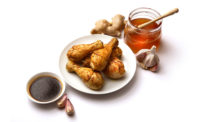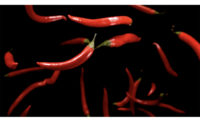Ingredients and Formulation
Further developments in spices & seasonings




Recently, more spices and seasonings are making their way into meat and poultry products for their antimicrobial and antioxidant benefits. While the use of spices and seasonings for flavoring and preserving has been in practice for centuries, many spices and seasonings are now being seen in a new light.
Only recently has research established the effectiveness of certain spices and spice extracts against microbial growth, lipid oxidation and their potential as natural antioxidants in raw meat and poultry, says Kantha Shelke, principal of Chicago-based Corvus Blue LLC. In the last 20 years, a number of factors — including international travel, globalization, the growing popularity of ethnic foods and the Food Network — have increased consumers’ familiarity with and desires for meats and poultry with various spices and seasonings, Shelke explains. As such, it is not uncommon today to see the meat and poultry aisle offering products containing seasonings and spices that were unheard of a decade ago.
A number of spices, including Syzygium aromaticum (cloves), Cinnmomum cassia (cinnamon), Origanum vulgare (oregano), Rosmarinus officinalis (rosemary), Zingiber officinale (ginger), Curcuma longa (turmeric), Cuminum cyminum / Nigella sativum (cumin/black cumin), Allium sativum (garlic) and Brassica nigra (black mustard) extracts and in combinations have shown to be effective against Salmonella typhimurium, Escherichia coli, Aspergillus sp and Candida albicans, Shelke says.
For example, garlic has shown to be effective against Staphylococcus aureus, Salmonella typhi, E. coli, and Listeria monocytogenes. In addition, cinnamon has shown to be effective against both gram-positive and gram-negative bacteria. Alcoholic extract of cinnamon (4 percent w/w) in combination with Lactobacillus acidophilusculture were more effective against the growth of aerobic bacteria and were good antioxidants as demonstrated by the lower thiobarbituric acid (TBA) values in meat and poultry treated with the combination, Shelke says. Cloves containing 14 to 21 percent essential oil, most of which is eugenol, can help kill bacteria including Salmonella typhi, Aeromonas hydrophila and E. coli along with viruses.
Working in spices and seasonings
Using antimicrobial and antioxidant seasonings and spices in meat and poultry is not without its challenges.
“Most spices and seasonings mentioned have distinct taste, aroma and sometimes also a distinct color, as in the case of turmeric,” Shelke says. “Meat and poultry manufacturers in the United States struggle with the use of highly aromatic, flavorful and color-rich seasonings and spices as antimicrobials and antioxidants without changing the taste or appearance of flagship finished products that are also often bland and with an established color and aroma that consumers have grown used to.”
Another challenge is the lack of a company’s familiarity and understanding of how to engage these various seasonings and spices in meats and poultry products in such a way as to enhance the safety of the finished products without turning off their customer base with the new and foreign flavors, Shelke adds. One of the first steps taken by savvy manufacturers, Shelke says, is the engagement of research chefs who have in-depth understanding of how to use spices and flavorings in meat and poultry products and who also have the fundamentals of food science to address the quality and shelf-life extension aspects of spices.
Research chefs can also aid in the effectiveness of the spices.
“The effectiveness of spices has a lot to do with what else is in the product and also on how the product is manufactured, stored and then prepared by the consumer,” Shelke says.
“It is important that the spice, seasoning or extract being used takes into consideration the preparation and the taste and quality of the product to ensure an experience that will make consumers return again and again for these safe and delicious products,” she adds.
But the most challenging part for the manufacturers is to ensure that the spice mix itself is clean and not contaminated with microbes. “Many spices come from tropical regions of the world, where microbial loads tend to be higher just as a function of the environment and the often poor hygiene in those regions,” Shelke says.
Advancements in seasonings and spices
Changes in consumer demand of meat products as well as increased global competition are causing an unprecedented spur in processing and ingredient system developments within the meat manufacturing sector.
“While consumers demand healthier meat products that also contain health-promoting bioactive components from spices and herbs, they also expect these meat products with altered formulations to taste, look and smell the same way as their traditionally formulated and processed counterparts,” Shelke says. “Suppliers are exploring ways to deodorize the natural plant extracts without changing their chemical and shelf-life extension properties.”
Consumers also readily accept products containing “natural,” non-synthetic components, she adds.
“That however excludes the use of BHA and BHT, which are, however, much stronger antioxidants than most currently known natural extracts,” Shelke says. “For this reason, the industry quest continues for natural plant extracts with a high antioxidant potential and low impact on taste and flavor.”
Moving forward, antimicrobial and antioxidant seasonings and spices are still going to be interesting ingredients in which to watch research development. For example, natural bioactive compounds from spices and other plant materials include a broad diversity of structures and functionalities that provide an excellent pool of molecules for the shelf-life extension of meats and poultry, Shelke says.
“While some of those compounds can be found in nature at high concentration, such as polyphenols, others can only be found at very low levels requiring use of large amounts of the spice for effectiveness, and making the finished product not as appealing or commercially viable,” she explains. “Commonly used methods for extraction such as the conventional liquid–liquid or solid–liquid extraction and advanced technologies such as pressurized-liquid extraction, subcritical and supercritical extractions, and microwave- and ultrasound-assisted extractions in conjunction with preparation steps such as enzyme-and instant controlled pressure drop-assisted extractions are now being explored to viably help release the ‘desired’ compounds from the matrix. These technologies could, in the next few years, provide an innovative approach to increase the production of specific compounds for use as natural antioxidants and antimicrobials for meat and poultry products.”
New combinations of herbs and spices as prophylactics with the effectiveness of the synthetic antioxidants and antimicrobials but with lower sensory attributes are also in the works, Shelke says. In addition, new techniques for preparing spices, such as cryogenic conditions for milling spices to retain effectiveness without increasing pungency and aroma, are being developed, she says.
Looking for a reprint of this article?
From high-res PDFs to custom plaques, order your copy today!









